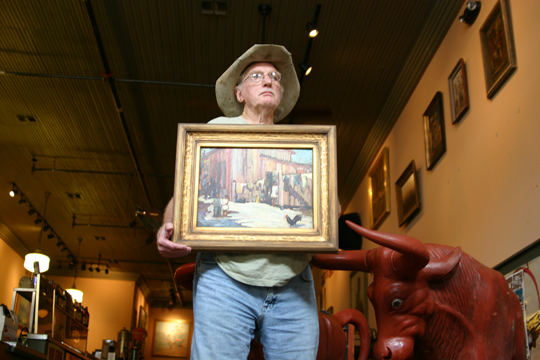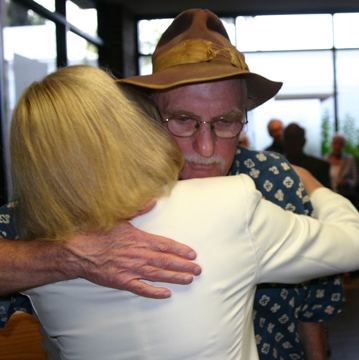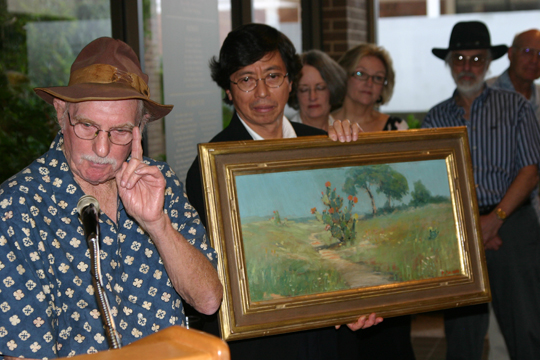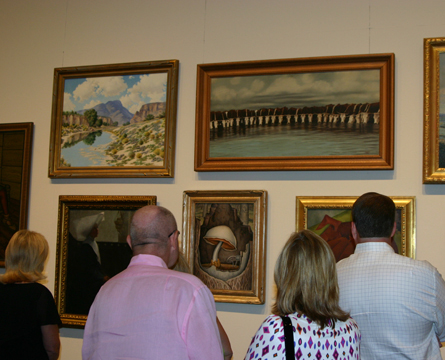Ragged children play in a San Antonio alleyway dotted with clothes hung out to dry and a strutting rooster. An artist captured the scene in 1932, an impressionistic look at life in one of the state’s hardscrabble pockets during the Great Depression.
 This latest addition to A.C. “Ace” Cook’s multimillion-dollar Hock Shop Collection of early Texas art isn’t the most valuable or sought-after of his approximately 350 purchases. But it’s important because it’s probably the last. Cook is battling pancreatic cancer. He figures he has limited days ahead and doubts he’ll buy another painting. “San Antonio Back Alley” by Edna Gertrude Collins is the cherry on top of a quarter-century spent collecting great works by Texas’ best early artists. Like other paintings in his collection, “Back Alley” shows Texas for what it was, not for what romantic painters or rich white folks paying commissions wanted it to look like. “Not everything was lily-white, not everything was sweet and nice,” Cook said. “This was a raw-ass state to start with.”
This latest addition to A.C. “Ace” Cook’s multimillion-dollar Hock Shop Collection of early Texas art isn’t the most valuable or sought-after of his approximately 350 purchases. But it’s important because it’s probably the last. Cook is battling pancreatic cancer. He figures he has limited days ahead and doubts he’ll buy another painting. “San Antonio Back Alley” by Edna Gertrude Collins is the cherry on top of a quarter-century spent collecting great works by Texas’ best early artists. Like other paintings in his collection, “Back Alley” shows Texas for what it was, not for what romantic painters or rich white folks paying commissions wanted it to look like. “Not everything was lily-white, not everything was sweet and nice,” Cook said. “This was a raw-ass state to start with.”
Depicting minorities with dignity was uncommon when artists put brush to canvas back in the early 20th century. Hispanics and African-Americans were sometimes mocked, mostly ignored, and rarely shown as proud people living lives of distinction. Cook has spent the past 25 years seeking, rescuing, and restoring these works by recognized artists (he seldom buys outsider or “folk” art). Many greenbacks later, Cook’s collection surpasses similarly themed ones held by the state’s best museums, and he’s credited with bringing overdue attention to Texas’ earliest painters. “This collection is a great achievement and a testament to Ace’s love of this region and his appreciation for the art of this region,” said Edmund “Ted” Pillsbury, former director of the Kimbell Art Museum and currently the fine arts chairman at Heritage Auction Galleries in Dallas. “Ace will be considered a pioneer collector of early Texas art, somebody who recognized the quality and value of these works and was one of the earliest and most successful and passionate collectors.”
The Hock Shop Collection, named after Cook’s years spent as a pawnbroker, will be exhibited through Oct. 26 at Tyler Museum of Art and then move to San Angelo Museum of Fine Arts to stay until January. What happens afterward is uncertain. A Fort Worth doctor gave Cook four to six weeks to live, but “that was six months ago, and I damn sure don’t look like a corpse,” he said. Chemotherapy treatments at Houston’s M.D. Anderson Cancer Center are subduing Cook’s cancer and buying him precious time – maybe months, maybe years. Still, he’s selling his collection, the entire shebang, one buyer take all. He hopes to have that buyer lined up before January.
In one way, it’s the end of an era. Cook is a colorful and controversial character, widely discussed, admired, and lambasted in art circles. Then again, it’s the beginning of an era. The Hock Shop Collection’s new owner might keep it all intact and even add to it (there are at least a dozen more paintings Cook has sought for years, to put the final touches on his thematic compilation). Or the new owner might sell, returning to the market some of Texas’ most-coveted canvases. Most of those who pay attention to Texas art would like to see the collection kept together. Its magic is in its wholeness. And they can think of no better place for it than in Cook’s adopted hometown with its world-class museum district. “I don’t want to speak out of turn, but if there was a serious effort on the part of Fort Worth, I don’t know that Ace wouldn’t step up and do his part as well, and not for personal aggrandizement – he would do it because it’s the right thing to do,” said Panhandle-Plains Historical Museum curator Michael Grauer.
Asking Cook about his latest acquisition spurs him to one of the subjects he’s most passionate about – the way minorities have been treated throughout Texas history. Racism and elitism touch nerves so deep in him it’s easy to forget he wasn’t any more open-minded than your typical redneck when he was growing up in Morton Valley, a little town west of Fort Worth, in the 1930s and 1940s. Back then, his views on “meskins” and “coloreds” fell in line with the racist thinking of most whites in the Southwest. But a storied life that included years as a commercial pilot, military man, labor union advocate, and pawnshop owner opened his eyes to low-income minorities plugging away each day despite playing against stacked decks. “Texas was a harsh place for people of color,” he said.
 We were sitting at a table outside the Fort Worth Community Arts Center on a recent afternoon, talking about the Hock Shop Collection, and Cook raised a few eyebrows among passersby who couldn’t help but notice his fervor. He talks loudly anyway, but a discussion about the Mexican War moved next to slavery, and the volume cranked up a notch. “In God we trust, and yet you’ve got a chain and a whip!” he said. “How would you like to be pulled from your wife and sold? Under God we trust. Horse shit! God didn’t have nothing to do with it.” I tried to move him toward a less volatile subject for public discussion, but he was revved up with no turning back. “You got to understand, that’s what this collection is about,” he said. “This is what I’ve tried to show. The early Texas artists were the very first to kick down the ugly door to segregation. It wasn’t the preachers. African-Americans couldn’t go to a white church. They couldn’t drink out of white fountains. They couldn’t go to a movie.”
We were sitting at a table outside the Fort Worth Community Arts Center on a recent afternoon, talking about the Hock Shop Collection, and Cook raised a few eyebrows among passersby who couldn’t help but notice his fervor. He talks loudly anyway, but a discussion about the Mexican War moved next to slavery, and the volume cranked up a notch. “In God we trust, and yet you’ve got a chain and a whip!” he said. “How would you like to be pulled from your wife and sold? Under God we trust. Horse shit! God didn’t have nothing to do with it.” I tried to move him toward a less volatile subject for public discussion, but he was revved up with no turning back. “You got to understand, that’s what this collection is about,” he said. “This is what I’ve tried to show. The early Texas artists were the very first to kick down the ugly door to segregation. It wasn’t the preachers. African-Americans couldn’t go to a white church. They couldn’t drink out of white fountains. They couldn’t go to a movie.”
In his early days of art collecting, Cook’s approach was like loading up a 12-gauge with birdshot, firing at a wall, and fetching whatever paintings got hit. Within a few years, however, he’d narrowed his search and figured out a theme – the working class in rough but beautiful Texas.
“What would you call it?” he wondered out loud. “Leftist? Democrat?” I suggested socialist. “Maybe,” he said. “Maybe I started looking at things a little different. I didn’t start out to build my collection like this. I was a pawnbroker and saw the plight of people who worked, and I studied how hard it was on them and what a hypocrite I had been earlier in life, thinking these people were nothing but deadbeats who relied on the government. I’d begun to realize that these people were human beings, no different than I, made by the same Creator that created me, and I started thinking about my collection and how I wanted to build it.”
One of the collection’s jewels is Douglas Chandor’s portrait of his gardener and friend, Alphonso. The English-born Chandor, a world-renowned portrait artist in the early 20th century, married a Texas gal and settled in Weatherford (his legacy includes Chandor Gardens). Chandor painted world leaders such as Franklin Delano Roosevelt and Winston Churchill. For him to paint an African-American gardener with such love and even to hang the portrait in his own home was unusual, to say the least. “If the right persons had seen it, they’d have beat the hell out of Chandor because this entire area – Dallas, Fort Worth, the Brazos bottoms – was loaded with Ku Klux Klan,” Cook said. “They’d have made damn sure Chandor never set his Yankee ass back in Weatherford. That’s what makes ‘Alphonso’ so great. Some people look at it and say that’s a nice painting. They don’t have any idea. They don’t even feel it.”
Cook is the opposite of a shrinking violet, and he was in full bloom and bellow, striking his open hand on a metal table outside the arts center. Tears filled his eyes. His voice cracked. Cook has always been blustery, but this rant was extraordinary even for him. I asked why he was getting so worked up about ancient history, and he appeared to get angry for a moment. “I don’t know; why don’t you tell me,” he said, his eyes narrowing. Then he suddenly softened. Women are emotional during the bulk of their lives while men are stoic, but those characteristics reverse later in life, he said. “Old men have a tendency to cry,” he said. “Old women don’t, but old men do. We have a tendency to shuck off our armor, our bulletproof vests, the bullshit that surrounds us, and show our true emotions.”
Shedding armor includes feeling remorse for a life not always lived in an exemplary manner. “You think back on the sins you’ve committed, the things you’ve said and done, the lies you’ve told, and the people and creatures you’ve hurt, and you feel a deep sorrow,” he said. “I used to be an alcoholic. You think that was neat for my family? I used to be a gutter rat, somebody that’s not worth nothing.” Stress from chemo treatments and getting his affairs in order have wracked his armor, but his tears have nothing to do with self-pity, he said. “It’s not about ‘Why me?’ ” he said. “I’m not that important. Nobody is. It’s about how precious life is. You don’t realize it until you know you are on the edge.” Being a fighter by nature, Cook’s every conversation about cancer is couched in boxing terms. He’s in a ring with a monster. He’s got to stay on his toes, remain focused. Get flatfooted or distracted, and Mr. Cancer delivers a knockout punch. “If he gets you in the corner, he’s gonna kill you,” Cook said. “He can kill you, but you can only put him back in his cage temporarily. You’re not ever rid of him when you’re where I’m at – stage-four cancer.”
 Focusing means putting aside his love of collecting. For years, seeking and buying regional masterpieces was his primary passion. He might dress down and talk with garbled grammar and mangled metaphors, but he’s known far and wide in the hoity-toity art world. That society didn’t know what to make of Cook when he hit the scene in the 1980s but finally came to embrace him. Still, some people grumble about his reputation for earning money in a profession often considered shady and about how he skinned many a sucker in lopsided art trades. Cook could care less. “Most of the people who say that, I would classify primarily as dumb-asses,” he said. Horse-trading is in his blood – his grandfather bought and sold horses for a living. Cook learned a trick or two, and by the time he was 16 he’d compiled an impressive gun collection. “I have no reason to cheat no one,” he said. “Sometimes people cheat themselves. Other times I’ve given people more than they were asking because they were [naming prices] so ridiculously low that I couldn’t in good conscience do it. But when it comes to horse trading, I’m not ashamed to say I can hold my own with them, especially when they are eat up with the dumb-ass.”
Focusing means putting aside his love of collecting. For years, seeking and buying regional masterpieces was his primary passion. He might dress down and talk with garbled grammar and mangled metaphors, but he’s known far and wide in the hoity-toity art world. That society didn’t know what to make of Cook when he hit the scene in the 1980s but finally came to embrace him. Still, some people grumble about his reputation for earning money in a profession often considered shady and about how he skinned many a sucker in lopsided art trades. Cook could care less. “Most of the people who say that, I would classify primarily as dumb-asses,” he said. Horse-trading is in his blood – his grandfather bought and sold horses for a living. Cook learned a trick or two, and by the time he was 16 he’d compiled an impressive gun collection. “I have no reason to cheat no one,” he said. “Sometimes people cheat themselves. Other times I’ve given people more than they were asking because they were [naming prices] so ridiculously low that I couldn’t in good conscience do it. But when it comes to horse trading, I’m not ashamed to say I can hold my own with them, especially when they are eat up with the dumb-ass.”
Some of his deals are now legendary, such as when he did some horse trading for a Frank Reaugh oil painting. Art critics consider Reaugh the father of Texas art and “Margaret’s Peak” one of his top efforts. The painting depicts a longhorn steer standing atop a West Texas peak. Cook yearned for the piece, but its South Carolina owner strung him along for months, refusing to name a price. Finally, the owner called with an offer – he wanted a prized jumping horse, and he’d trade the painting for the cost of the horse. “I said how much is the damn horse? He said they wanted $40,000 for him. I said that’s a lot of horse,” Cook said.
He cashed in a bundle of AT&T stock and traded for Reaugh’s classic image. Ten years later, Cook figures he came out way ahead – the painting might fetch a half-million at auction.
“A good early Texas painting will always outgrow any stock you have,” he said. “AT&T stock you can buy every day of the damn week. I can’t buy a Frank Reaugh every day of the week. They don’t come along.” He’s also found rare but abused paintings in garage sales and flea markets, buying them for next to nothing and paying 20 times the sale price to have them cleaned and restored. “I brought attention to the working-class people in this state and attention to very rare native American, Mexican or Spanish, and African-American artists that painted here but were not recognized,” he said. “I’ve sought these works out. They’ve been hard to find, but I found them. When I look at them I feel a sense of accomplishment that I’ve done something worthwhile, and people can see them and understand the toils and how hard it was for these people.”
 Building the collection as his legacy was satisfying, but he knew it was time to let go when the Tyler museum came calling earlier this year, wanting to exhibit his best works, and Cook couldn’t muster the energy to consult on every detail, something he’d always reveled in. “When you’re in a death match, you don’t have time to get involved,” he said. “I don’t have time to worry about small shit. I have to worry about living and getting the most out of it.” The Tyler Museum of Art, like other museums, paid little attention to Texas’ early painters until recently.
Building the collection as his legacy was satisfying, but he knew it was time to let go when the Tyler museum came calling earlier this year, wanting to exhibit his best works, and Cook couldn’t muster the energy to consult on every detail, something he’d always reveled in. “When you’re in a death match, you don’t have time to get involved,” he said. “I don’t have time to worry about small shit. I have to worry about living and getting the most out of it.” The Tyler Museum of Art, like other museums, paid little attention to Texas’ early painters until recently.
Most museums traditionally offer ancient works or European art or contemporary paintings from big-city artists, while yawning at regional talent. One of the first to break the mold was the Panhandle Plains Historical Museum in Canyon, which devotes much of its space to this genre. Curator and author Grauer has a theory on why Texas’ early regional art has been overlooked by so many museums. “It’s the overarching fear of being seen as provincial,” he said. “These museums are terrified somebody is going to think they are a bunch of rubes if they show something native to the state.”
That kind of blunt honesty rarely comes from curators, and Grauer’s forthrightness reflects Cook’s influence. In the mid-1980s, Grauer wrote his master’s thesis on Reaugh and then went to work at Panhandle Plains. Cook introduced himself a short time later and demanded to know why in the hell Texas museums didn’t appreciate native painters. “Ace is not shy about voicing his concerns,” Grauer said. “He’s a zealot, and he’ll preach to anybody who’s willing to listen. He preaches the gospel of early Texas art, and fortunately there are people willing to sit in his congregation, and I’m one of them. I’ve been sitting in the front pew since 1989 when I met him.”
Panhandle Plains became a pioneer in showcasing the art and the first museum to feature the Hock Shop Collection, in 1997. “In terms of quality, depth, and breadth, it is the finest collection of early Texas art in private hands,” he said. “Ace only picks the best, and if he doesn’t have the best, he upgrades until he does. There’s a perception that he is only interested in ethnic artists, but really he just wants them included in the conversation. It’s unfathomable to him when they are not included, and most of the time they have not been.”
Grauer is among those who want the Hock Shop Collection kept intact and displayed in Fort Worth. He even thinks he knows the perfect spot for it – Fort Worth Community Arts Center, former home to the Modern. The idea may sound good, but it’s impractical. The facility is city-owned and being fully utilized, said Morris Matson, a former Fort Worth finance director and city councilman, unofficial docent for the Hock Shop Collection, and Cook’s best friend. Museums are expensive, and it’s no coincidence the city’s best were built with private money by rich families wanting to keep their art collections together and on display locally, Matson said. Cook is a self-made man, but nowhere in the financial league of folks like Amon Carter, Kay Kimbell, and Sid Richardson. “All it takes is an angel – an angel with a big pocketbook,” Matson said.
In recent years the collection has been on display in Cook’s ice cream and beer parlor, the Bull Ring, in the Stockyards. Matson thinks it’s the perfect place but won’t guess what will become of the collection in the coming years. Cook is close-mouthed about potential buyers. “It’s hard to tell in this economy the way things may go, but a number of people have expressed interest in the collection, and Ace seems committed to finding somebody who will keep it together so it can be seen,” Matson said. “Whether it will stay in Fort Worth remains to be seen.” Two things besides money are probably working against Cook being able to place the collection in a museum: provincialism and Cook’s own style, which can be off-putting to those who cultivate art’s tradition of sophistication and culture. “He’s rough around the edges, you bet, but he’s also got the best eye of any collector I know,” Grauer said. “You wouldn’t know it by talking to him, because he’s not going to let you know that. He puts on that Yosemite Sam persona, and the glitterati of Fort Worth don’t want anything to do with that. But if the collection is not kept intact and kept in an institution – and it ought to be in Fort Worth, Texas – we will look back and lament the fact that we didn’t find a way to keep it together.
” How much would the collection fetch? “It’s priceless,” Grauer said. “I don’t think he even knows how many pieces are in it.” The best works are now at Tyler’s museum, which began showcasing contemporary regional art in the 1970s but only recently began incorporating early regional art. Tyler Museum’s curator Ken Tomio said his board realized that early Texas art provided continuity with the museum’s existing permanent collection. Tomio and his wife, the museum’s director, Kim Tomio, were introduced several years ago to Cook and Matson, both of whom provided guidance and information to the museum. When word leaked several months ago about Cook’s cancer battle, the Tomios came calling. They planned a Hock Shop exhibit in a hurry, wanting Cook to see the finished product. “I’ve seen [the paintings] up on the Bull Ring wall, but I’m impressed anew, as you put them up and start lighting them, with how strong they are,” Ken Tomio said. “It’s powerful stuff and something that people can understand immediately.”
More than 250 people showed up for the exhibit’s private opening reception in Tyler, and the combination of representational and impressionist landscapes, street scenes, and portraits seemed to wow the crowd. Most guests were older and white, but a group of local teenagers also came, including John Peck, a 17-year-old Hispanic kid. He didn’t know anything about Cook or the collection and hadn’t read the exhibit catalog, but he quickly latched onto the fact that the paintings depicted minorities without exploitation. “It’s not all about their struggles,” he said. “It’s just scenes of simple living, people working jobs and doing everyday things. It makes me glad somebody got out there and caught what was happening, things that some other people might have looked down on.”
Cook was relaxed and his old self during a recent drive to Palo Pinto County. The angst he had displayed outside the arts center the week before was gone, and he spent most of the trip marveling at everything’s beauty – the trees, sky, birds, clouds. Months had passed since he last got the chance to visit his dream spot – 485 acres of hilly ranchland about an hour’s drive west of Fort Worth. He bought the land five years ago and planned to build his dream home. Now he’s unsure. If doctors indicate he might live a few more years, he’ll build a house and spend time on the porch listening to Hank Williams, Willie Nelson, and Johnny Cash and watching his 2,000-plus native pecan trees sway in the wind. Whether he gets to do that or not, his diagnosis has given him time to think about mortality. As a long-time commercial pilot, he’s had similar thoughts before, but nothing like this. “This ain’t the first time I’ve had my ass hung out over a fence, but never this far,” he said, recalling several bad-weather flights that made him send up prayers. “But that’s just an adrenalin rush, and in a day and a half it’s gone. Not like now. I wake up at one or two every morning, and I ask Jesus Christ to help guide and strengthen me. I didn’t do that after the adrenalin rushes.”
He drove slowly on I-20, staying in the right-hand lane and setting the cruise control at just under 60. No hurry. He wanted to absorb everything. He’d love for his art collection to stay in Fort Worth, but the topic doesn’t take up much of his thinking these days. He’s more interested in watching Palo Pinto Creek run through his property or checking his salt licks to see whether critters have been taking a taste. His art collection – like him – will follow its fate and end up where it’s meant to be. “I have great faith in the almighty and Jesus Christ, and I’m going to go where he leads me,” he said. “I’m not looking for a miracle. If we want a miracle, we’ll wish something for the children down there at Cook Hospital, certainly not for some old worn-out person like myself.”
He takes great pride in the Hock Shop Collection, but he’s ready to put it in other hands. He judges himself not merely as an art historian and collector but as a man of many talents. His passion is undiminished, but he has channeled it into another arena. “Putting together the collection was an interest to me, but it wasn’t the sum total of me,” he said. “It’s not like cutting off an arm. I’m in another phase in my life. I’m in my 70s, fighting a rare and deadly cancer. Now that I’m in this fight, it’s another trip for me. “The reality is, the Hock Shop Collection needs to go somewheres else. I’ve left that behind me.”












